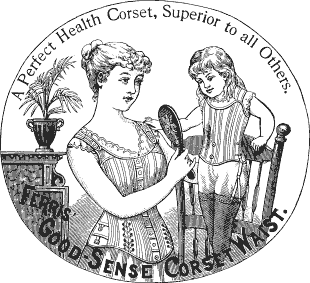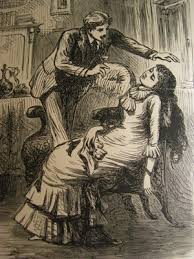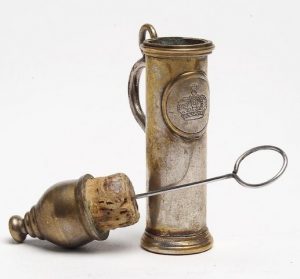“Beware of fainting-fits… though at the time they may be refreshing and agreeable, yet believe me: they will, in the end, if too often repeated and at improper seasons, prove destructive to your constitution.”
~Jane Austen, Love and Friendship

As a lover of all things classic and bookish, I find it fascinating that women in 19th century novels were commonly portrayed fainting. They faint when anything scary, shocking or surprising happens. They faint at moments of emotional intensity. They faint whenever they try any hard physical work.
In Dickens’ Pickwick Papers female characters swoon repeatedly. And who can forget Jane Austen’s portrayal of Mrs. Bennet in Pride and Prejudice (you knew I’d work that one in if I could) keeping to her rooms for fear of fainting under the stress of her daughter’s elopement with the dastardly Mr. Wickham.
Some historians suggest that fashion may have played a part.
 Corsets were very common among the upper classes. Worn around the torso, corsets were made of a durable tightly woven fabric or leather, fashioned with channels running throughout them in which vertical ribs were inserted, called boning because they were often made with whale bone. The entire device was held together, and tightened, sometimes to extremes, by a system of lacing. Girls were started in corsets at a very young age and, for them and ladies after childbirth, waist training, to shrink the side of the waist, via super tight lacing, was common. Over time, corset-wearers’ bodies changed—their ribs were displaced, their lungs were squashed, some organs were compressed against the spine and others were shoved down into the lower abdomen. In addition to making it hard to breathe, hearts struggled to pump and, stomachs struggled to digest what little food they could get down. As one Victorian lady reported, “I had only eaten two bites of my biscuit there was no room beneath my corset for a third.”
Corsets were very common among the upper classes. Worn around the torso, corsets were made of a durable tightly woven fabric or leather, fashioned with channels running throughout them in which vertical ribs were inserted, called boning because they were often made with whale bone. The entire device was held together, and tightened, sometimes to extremes, by a system of lacing. Girls were started in corsets at a very young age and, for them and ladies after childbirth, waist training, to shrink the side of the waist, via super tight lacing, was common. Over time, corset-wearers’ bodies changed—their ribs were displaced, their lungs were squashed, some organs were compressed against the spine and others were shoved down into the lower abdomen. In addition to making it hard to breathe, hearts struggled to pump and, stomachs struggled to digest what little food they could get down. As one Victorian lady reported, “I had only eaten two bites of my biscuit there was no room beneath my corset for a third.”
Another fashion-based theory is that a well dressed woman of this era wore an enormous amount of clothing. In addition to her corset, such a lady would undergarments, a bustle pad, a full skirt supported by crinoline petticoats, sometimes lined with steel hoops, and a bonnet. Some may have fainted from overheating, while others may have collapsed under the sheer weight of their garments and their tightly cinched corsets.
Another possible explanation for some of the swooning could have been chronic poisoning. During the 19th century, while people knew that arsenic was poisonous, they didn’t understand that external exposure from its fumes could also be harmful. The toxin was widely used in the manufacture of everything from fabrics to paints to the paper in which food was wrapped; in fact, by the end of the 1800s, 80% of all wallpaper was arsenic-laced. Arsenic poisoning has a variety of symptoms including headaches, cold sweats, and fainting.
In addition, arsenic, along with lead, mercury and other such toxic substances, were commonly found in makeup during the Victorian era. Lead was also a common ingredient in hair dyes and was frequently found in wine, along with arsenic and copper. Together, these toxins contributed to more wealthy Victorians suffering from seizures, and theoretically swooning, when compared with their poorer neighbors who couldn’t afford such luxuries.
Was Swooning a Fad?
 Even more curious is that the phenomenon appeared to be more common among middle and upper class women, or so literature would have you believe. Upper-class women, especially young women, were expected to be more delicate, more emotional, and more easily distressed as opposed to women of the working classes. Leaving many social historians to believe that all swooning was nothing more than a put on. Besides potential side effects from tightly laced corsets or the exposure to toxins, fainting became expected and downright ladylike. Women of particularly of high station were expected to act the role of a delicate flower, while men were expected to be hard as nails. Swooning was simply one method for a woman to demonstrate her femininity. Well-to-do women often had something called a “fainting room,” a special location where she could recover a fainting spell in private.
Even more curious is that the phenomenon appeared to be more common among middle and upper class women, or so literature would have you believe. Upper-class women, especially young women, were expected to be more delicate, more emotional, and more easily distressed as opposed to women of the working classes. Leaving many social historians to believe that all swooning was nothing more than a put on. Besides potential side effects from tightly laced corsets or the exposure to toxins, fainting became expected and downright ladylike. Women of particularly of high station were expected to act the role of a delicate flower, while men were expected to be hard as nails. Swooning was simply one method for a woman to demonstrate her femininity. Well-to-do women often had something called a “fainting room,” a special location where she could recover a fainting spell in private.
In Bleak House, Dickens’ character, Lady Dedlock, swoons at the first hint her hidden past, a secret affair and child, may be revealed. Dickens also ridicules characters who swoon as part of a social performance. Mrs Gamp in Martin Chuzzlewit is portrayed as manipulating those around her by “wilting on demand.”
Lady Revivers
 Smelling salts, also known as “lady revivers,” were the most common method used for rousing a fainting damsel. However there is no salt in smelling salts at all. The active ingredient is ammonium carbonate, a solid compound that when mixed with water releases an ammonia gas that irritates the lining of the nose and the windpipe, heightening a person’s alertness.
Smelling salts, also known as “lady revivers,” were the most common method used for rousing a fainting damsel. However there is no salt in smelling salts at all. The active ingredient is ammonium carbonate, a solid compound that when mixed with water releases an ammonia gas that irritates the lining of the nose and the windpipe, heightening a person’s alertness.
While fashionable Victorian ladies might have a “fainting room” inside in case a sudden fit befell them, if a woman was overcome while out and about the situation might prove more perilous. Police constables of the era were equipped with small vials of smelling salts to assist afflicted women in the streets.
So what do you think? Was the sudden surge in fainting spells among Victorian upper-class women a result of tight corsets and arsenic-laced cosmetics, or was it a social fad, a way to prove your delicate femininity?





